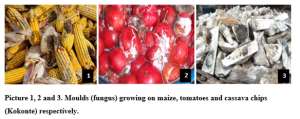
In 2004, 125 people died and nearly 200 others were treated after eating mycotoxins-contaminated maize in Kenya. Smaller outbreaks occurred in 2005 and again in 2006 in Kenya, with another 53 fatalities. In the 1980s, kwashiorkor children in Sudan showed highest frequency of mycotoxin (aflatoxin) in their serum.
Many Ghanaian foods prepared to eat or unprepared and sold in public markets have been revealed to be highly contaminated with mycotoxins.
Contamination of cassava, for instance, has been documented in Ghana, Mozambique, and Burundi. In some years past, a post mortem operations of 22 children who died of kwashiorkor in Ghana showed that the livers of these children had mycotoxins; no other chemical contaminants were detected.
A recent research at the Noguchi Memorial Institute for Medical Research by Kumi (PhD) and colleagues in 2014, detected unacceptable levels of mycotoxins (aflatoxin and fumonisin) in home-made food (weanimix) for infants; this food meant to improve infants nutrition, rather expose them to adverse health implications with respect to immunity and growth.
WHAT ARE MYCOTOXINS AND THEIR HEALTH IMPLICATIONS
Mycotoxins are chemical contaminants produced by fungus (moulds) found on/in foods. Foods such as maize and maize beverages, rice, groundnut, millet, spices and apple are prone to mycotoxin contamination. On a bad side, the high moisture and temperature conditions typical of Africa is ideal for the flourishing of these moulds.
Consuming an appreciable amount of mycotoxin-containing food could lead to liver and kidney damage, reproductive disorders, limbs inflammation, appetite loss, digestive tract discomfort, diarrhoea, immune system suppression, cancer development, and death.
HOW TO DETECT MYCOTOXINS IN FOODS AND AVOID THEM
The only proven way to determine, if a food contain mycotoxins or not, is to conduct a test. However, one might suspect contamination if certain signs or characteristics appear in/on food. Such signs in maize and groundnut, for example, include visually discoloured and wrinkled kernels; musty odour; lighter weight of kernels than usual.
On freshly and highly perishable foods (like apple and banana), the presence of a fuzzy/fluffy orange, whitish, or grayish coloured ‘substance’ is a good indication of a growing-fungus. One should therefore examine foods critically before buying and/or consuming them.
Also, animals (e.g. dairy cow) fed with mycotoxin-containing feed can pass the mycotoxins through their milk to a human consumer. There is therefore the need to be mindful of what we feed our food-animals with.
A worthy approach is to prevent/reduce the growth of mycotoxins-producing moulds in/on food/feed, because once an appreciable amount of mycotoxins are produced, it becomes very difficult and expensive to remove/alter them. Even high temperature treatments, such as cooking, do not destroy some mycotoxins, once they are produced in food.
Everyday precautionary measures:
Foodstuffs such as maize should be dried sufficiently to discourage the growth of moulds, especially if they are to be stored for long. Kitchens and storage rooms should not be damp, but dry and airy. Cooked foods may be kept covered to prevent exposure to moulds in the air. Once opened, transfer perishable canned foods like tin-tomatoes into clean non-metallic containers and refrigerate them promptly; perishables like apples, tomatoes should not be left out of the refrigerator for too long; refrigerators, utensils, dishtowels, and the entire kitchen should be kept clean and hygienic, for this is vital in controlling the proliferation of mycotoxin-producing moulds.
With this understanding, consumers should not panic. Instead, we should be more watchful of how we handle our foods, what we buy and eat.
 Mouldy Maize-
Mouldy Maize-




 Dumsor: Don't rush to demand timetable; the problem may be temporary — Atik Moha...
Dumsor: Don't rush to demand timetable; the problem may be temporary — Atik Moha...
 Space X Starlink’s satellite broadband approved in Ghana — NCA
Space X Starlink’s satellite broadband approved in Ghana — NCA
 2024 election will be decided on the grounds of the economy; choice of running m...
2024 election will be decided on the grounds of the economy; choice of running m...
 Dumsor: We're demanding less; just give us a timetable — Kwesi Pratt to ECG
Dumsor: We're demanding less; just give us a timetable — Kwesi Pratt to ECG
 Do I have to apologise for doing my security work, I won’t – Simon Osei-Mensah r...
Do I have to apologise for doing my security work, I won’t – Simon Osei-Mensah r...
 All my businesses have collapsed under Akufo-Addo — NDC Central regional chair
All my businesses have collapsed under Akufo-Addo — NDC Central regional chair
 Military, Prison Officers clash in Bawku, three injured
Military, Prison Officers clash in Bawku, three injured
 GRA-SML contract: MFWA files RTI request demanding KPMG report
GRA-SML contract: MFWA files RTI request demanding KPMG report
 Court threatens to call second accused to testify if NDC's Ofosu Ampofo fails to...
Court threatens to call second accused to testify if NDC's Ofosu Ampofo fails to...
 Family accuses hospital of medical negligence, extortion in death of 17-year-old...
Family accuses hospital of medical negligence, extortion in death of 17-year-old...
